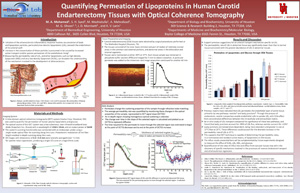An undergraduate research project at the University of Houston was recognized recently at the Society of Mexican American Engineers and Scientists (MAES) Symposium 2010 poster competition.
Biomedical engineering junior Mohamed Mohamed captured first place in the competition by showcasing work performed in the Biomedical Optics Laboratory at the UH Cullen College of Engineering.
Specifically, Mohamed has been working to quantify the permeability rates of lipoproteins, or cholesterol transporters, and other biologically relevant molecules through carotid tissue, the aortic branch supplying blood to the head.
His results verify the diffusion of low-density lipoprotein (LDL) into the inner lining of arteries, which is assumed to be the leading cause of atherosclerotic plaque formation. Atherosclerosis is a condition that develops due to the buildup of fatty substances inside arterial walls.
Utilizing a non-invasive imaging technique known as Optical Coherence Tomography (OCT), Mohamed was able to measure the permeability rates of lipoproteins such as LDL and high-density lipoprotein (HDL) in the tissue.
Much like ultrasound, which uses sound waves to create images, OCT works by capturing backscattered and backreflected light emitted from an infrared laser. A detector captures optical signals reflected off tissue samples to form structural images.
In this case, Mohamed was able to analyze the changes caused by the light scatter off the carotid tissue. What he found is that, though twice the size, LDL diffused quicker than HDL, verifying that LDL is being actively transported into the carotid tissue and subsequently triggers the onset of atherosclerosis.
"What we were able to do here is verify this fact with a non-invasive method," he said. "In the future, we might be able to figure out how effective certain drugs are in preventing and treating atherosclerosis."
Mohamed plans to continue perfecting the method under the direction of Kirill Larin, associate professor of biomedical engineering and director of the lab, and Mohamad Ghosn and Joel Morriset of Baylor College of Medicine.
